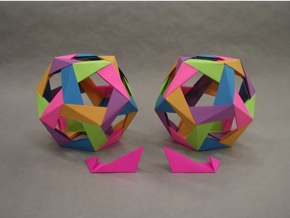Â
What Origami Polyhedra Can Teach
Â

Secondary
students are expected to be ready for a rigorous study of geometry,
including three dimensional relationships, though their K-8 mathematics
preparation focused mainly on naming shapes and relationships such
as parallel or perpendicular, with infrequent opportunities to develop
geometric reasoning. They also spend less time engaged in activities
that develop geometric reasoning and spatial visualization skills,
than in generations past. While many students may build with Legos
as young children, most quickly move to video games, where they
spend their time manipulating two-dimensional images of three-dimensional
worlds. They spend less time constructing scale models, doing jigsaw
puzzles, sewing from patterns or climbing trees than earlier generations.
They arrive in secondary geometry classrooms with weak spatial reasoning
and poor visualization skills.
Modular origami provides a rich environment for engaging students in three-dimensional exploration and model building. Folding individual units provides opportunities for introducing or reviewing geometric concepts and vocabulary. Assembling them involves the development of spatial reasoning and visualization. The results provide aesthetically pleasing and affordable models for students to use in furthering their studies of polyhedra and three-dimensional relationships.
The creation of models from three distinct families of modular origami polyhedra models provides environments for investigating different characteristics of Platonic and Archimedean polyhedra. Face models help students to cnnect polygons and polyhedra, especially visualizing the relationship between nets and solids. Skeletal models can be used to focus on axes and planes of symmetry, and the relationships between duals. Edge models can be used to investigate connections to graphs and Schliegal diagrams, coloring arrangements, and surface and dihedral angles along with the angle deficits at vertices. Since many modular origami pieces have rotational but not bi-lateral symmetry, the construction of models from all three families provide rich opportunities to introduce the concept of chirality.

Â

Â